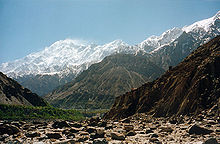- Nagar (princely state)
-
This article is part of the seriesFormer administrative units of PakistanOriginal provincesMinor statesOne-unit provincesOther subdivisions
Nagar 
Capital Nagar Area 5,000 km² Languages Burushaski
ShinaEstablished 14th century Abolished 25th September, 1974 Nagar (Urdu: ریاست نگر, riasat nagar) was a princely state in the northernmost part of Gilgit-Baltistan in northern Pakistan, which existed until 1974. The state bordered the Gilgit Agency to the south and west, and the former princely state of Hunza to the north and east. The state capital was the town of Nagar. The area of Nagar now forms three tehsils of Hunza-Nagar District. Nagar along with Gilgit and Baltistan is claimed by India as part of the state of Jammu and Kashmir.
Contents
History
Nagar was an autonomous principality in close association with neighbouring Hunza. The British gained control of both states 1889 and 1892. The British retained Nagar's status as a 'principality' until 1947 but together with Hunza it was considered a vassal of Jammu and Kashmir, although never ruled directly by it. The rulers of Nagar sent annual tributes to the Jammu and Kashmir Durbar until 1947, and along with the ruler of Hunza, were considered amongst the most loyal vassals of the Maharajas of Jammu and Kashmir.
In 1947, the state acceded to Pakistan, but continued as semi autonomous state. In 1968 Syed Yahya Shah the first educated politician of the valley, demanded civil rights from the Mir of Nagar. When Ayub Khan's dictatorship ended in Pakistan and the democratic government of the Pakistan Peoples Party under Zulfiqar Ali Bhutto came into power through elections it realized the sentiments of the people against the Mir for democracy so the Government freed the prisoners of the movement and dissolved the Mirs of Hunza and Nagar and were merged into the Northern Areas in 1974.[1]
Government
The state was governed by the hereditary rulers of the Maghlot dynasty who were styled as Mir and were assisted by a council of Wazirs or Ministers. Details for early rulers are uncertain with the first definite dates available from 1839 CE onwards. Brigadier Mir Shaukat Ali Khan was the ruler of the State when it was abolished by the PM of Pakistan Zulfiqar Ali Bhutto in 1972.
Geography
The geography of Nagar was very difficult mountainous terrain, which provided a certain degree of protection against invading forces. The highest mountain was the 7,788 m (25,551 ft) Mount Rakaposhi which lay to the south of the town of Nagar. As of 2009[update], the Karakoram Highway crosses Nagar, connecting Pakistan to China via the Khunjerab Pass. The road follows the Hunza river for some distance through Nagar and into the Hunza region.
Demographics
The inhabitants of the Nagar valley is around 90,000 (AKRSP Census, 2000). Nagar is home of people of two main ethnicities — the Burushaski speakers and the Shina speakers. The older type of Burushaski is still spoken in this valley with mild modern accent.
Religion
Although the population was traditionally predominantly shia (Jafria). Following sectarian violences in January 2005, the Tanzim Ahle Sunnah wal Jama’at representing Sunnis, and the Central Anjuman-e-Imamia Northern Areas representing (Jafria) Shias signed on February 18, 2005 a six-point peace agreement arranged by Northern Areas Legislative Council (NALC) members to ensure peace in the city[3].
References
- ^ Buroshall Say Nagar Tak ka Safar, by Muhammad Ismail Tehseen, Brushal ke Qabail by Syed Yahya Shah, books written in Urdu available in Municipal library Gilgit
- ^ Ben Cahoon, WorldStatesmen.org. "Pakistan Princely States". http://www.worldstatesmen.org/Pakistan_princes.html#Nagar. Retrieved 2007-10-03.
- ^ Ibrahim Shahid, Sunni and Shia groups sign peace deal in Gilgit, Daily Times (Pakistan), Sunday February 20, 2005
Further reading
- Buroshall say Nagar Tek Ka Safar by Mohammad Ismail Nashad.
- Rasala Buroshall by Syed Mohammad Yahya Shah.
- Where the three Empires meet by E.F.Knight /Zafar Hayat Paul
See also
- Hunza
- Gilgit-Baltistan
- Karakoram Highway
- Karakoram Mountains
- Nagar Valley
- Hispar Valley
- Hopar Valley
- Spantik
- Diran
- Bar Valley
External links
Reign Mirs of Nagar[2] Unknown dates Fadl Khan Unknown dates Daud Khan Unknown dates Ali Dad Khan (1st time) Unknown dates Hari Tham Khan Unknown dates Ali Dad Khan (2nd time) Unknown dates Kamal Khan Unknown dates Rahim Khan I Unknown date - 1839 Rahim Khan II 1839 - 1891 Jafar Zahid Khan (1st time) 1891 - 1892 Raja Azur Khan (acting) 1892 - 1904 Jafar Zahid Khan (2nd time) 1905 - 17 March 1940 Raja Mir Iskandar Khan 17 March 1940 - 25 September 1974 Shaukat Ali Khan (1930-1976) 25 September 1974 State of Nagar dissolved After nagar State Dissolved in 1974 Elected Representatives of Nagar in Gilgit Baltistan legislative Council 1975 Syed Yahya Shah 1980 Mir Shaukat Ali Khan 1985- Qurban Ali 1997- Mir Shaukat Ali Khan-Nagar-1 Shiekh Ghulam Haider-Nagar-2, 2000 -Qurban Ali-Nagar-1, Shiekh Ghulam Haider-Nagar-2 2005 Mirza Hussain-Nagar-1,Muhammad Ali Akhtar-Nagar-2 2009 Mirza Hussain-Nagar-1 Muhammad Ali Akhtar-Nagar-2 Categories:- Former administrative units of Pakistan
- Indian Princely States
- Muslim princely states of India
- Regions of Gilgit-Baltistan
- States and territories established in the 14th century
- 1974 disestablishments
- History of Gilgit-Baltistan
Wikimedia Foundation. 2010.



